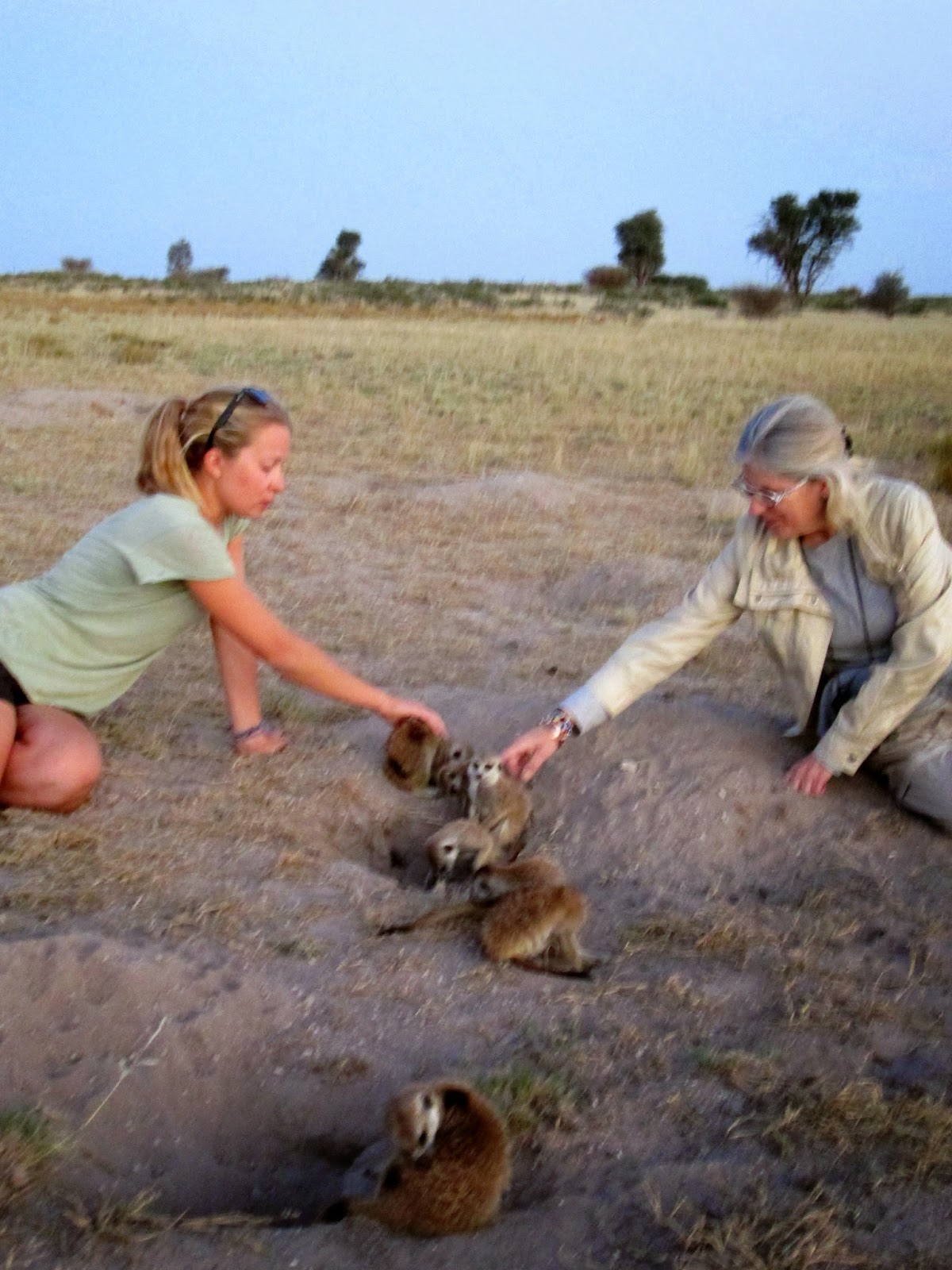 |
| Kalahari sunrise with the moon and Venus |
There are 40 researchers living on the grounds of the reserve on land that was formerly San homelands and more recently Afrikaner farmlands. They study the pint-sized mammals along with mole rats and squirrels. You would think that with 40 researchers studying meerkats for 20 years you would know everything there is to know about the behavior of the meerkat, but no. There is more than enough to still learn about them apparently and plenty of scientists clamoring to do the work.
 |
| Kalahari sunset |
The first group we visited lived on an open flat land with many holes all connected underground. Meerkats prefer to squat in and adapt old squirrel holes rather than dig their own. This particular underground habitat is spread over a fairly large area. So in order to pick the right hole to hover over and wait for the meerkats to emerge for their breakfast forage, Katy used her locating wand to "listen" for their activity underground. She found the right place ... so we sat ... and waited. In about a half an hour, out emerged the first of the meerkats, the dominant male. There are 7 adults and juveniles in this family and two little meerkat pups.
 In order to assure the meerkats that it is safe to emerge and we are okay to approach, Katy hums a little habituation tune that the meerkats identify with "friend". They are very habituated which is handy because Katy has to then weigh every one before they eat. (She repeats this at night after their dinner forage.) She lures them over to the scale with water and pieces of hard boiled egg which she calls "yum yums."
In order to assure the meerkats that it is safe to emerge and we are okay to approach, Katy hums a little habituation tune that the meerkats identify with "friend". They are very habituated which is handy because Katy has to then weigh every one before they eat. (She repeats this at night after their dinner forage.) She lures them over to the scale with water and pieces of hard boiled egg which she calls "yum yums."Some already know there is egg coming so they hop into the scale to be weighed and rewarded.
The pups are less than 3 weeks old and their sex has not been identified nor have they been weighed. Today is the day. Katy first lures them out of the hole with egg,
Gotcha!
There is one male and one female.
 |
| Katy lures a meerkat away from the scale w some "yum-yums" |
Sometimes Katy must use diversionary tactics to keep them all from hopping into the scale bucket to be weighed and rewarded. In the end, she weighed them all.
She keeps track of their growth progress on a chart. The meerkats have all been named and marked with hair dye to easily distinguish one from the other.

We all basically just hung out and observed while the meerkats foraged for insects all over the reserve. They are delightful!

And we took tons of pictures.We stayed with the family until they were finished foraging for insects and grubs, preened, nursed their pups and descended into their burrows for a mid-day nap. Katy also documents the time they emerge from the burrow and retreat every morning and evening.

For the afternoon session we visited another family who live in burrows under the high sour grass across the road. They were already out foraging when we got there and it was a little difficult to find the little creatures at first in the high grass. But we did.
When they are out and about in the sparser lands around their burrows, they are much easier to follow. They run on all fours with their dark tails straight up in the air like a rudder. I have a new reference for measuring the height of sour grass. This patch was "taller than a meerkat's tail". But Katy has the eye for their movement and the divining rod to help read their location so we wasted no time finding them out on their dinner forage.
Back near the burrow, these guys were easy to weigh and identify. They are very habituated and quite used to people and cameras. These seven adults and juveniles and their ancestors before them were the actual stars of Meekat Manor. They approached the cameras easily and we have great footage of the juveniles sticking their noses right into the GoPro lens that we laid on the sand in front of the burrow entrance.
Katy encouraged us to approach and scratch them on their necks.
No need to ask us twice!
So sweet.
Thanks Katy! Thanks meerkats!




















No comments:
Post a Comment